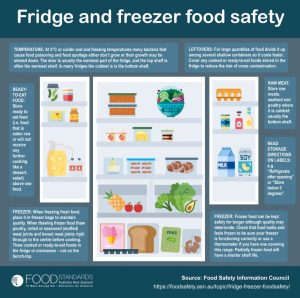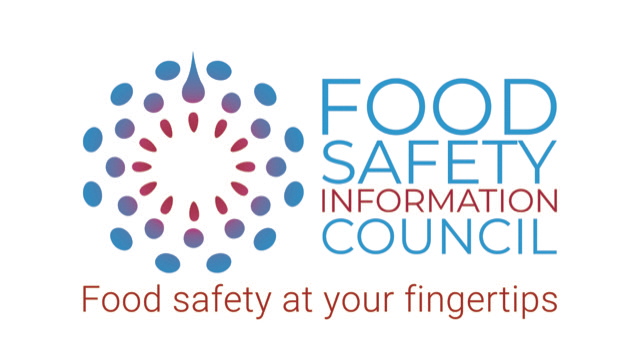
According to recent research, most Australians don’t know that cold food should be stored at or below 5°C. Yet doing this can considerably reduce the chances of you or your family getting food poisoning.
Watch our short video on fridge safety
Why store food in your fridge or freezer
Storing perishable foods and food ingredients in the fridge or freezer is primarily to prevent food poisoning or to slow down spoilage and loss of food quality. At 5°C or colder and at freezing temperatures many bacteria that cause food poisoning and food spoilage either don’t grow or their growth may be slowed down. Remember though that there is a limit to how long food can be refrigerated as it will eventually spoil and the quality deteriorate and some food poisoning bacteria such as Listeria monocytogenes can grow and cause infection (see Advice on Listeria). Frozen food can be kept safely for longer although quality may deteriorate.

Get a fridge thermometer
To check if your fridge is operating at the correct temperature you need to purchase a thermometer and place it in the fridge. When you do this you might get some surprises. The temperature inside your fridge will vary several degrees as the fridge goes through its cycle. It will also vary markedly from one section to another.
The door is usually the warmest part and the top shelf is often the warmest shelf. We suggest you place your thermometer below the top shelf and towards the door to give a general indication of the fridge temperature.
If the thermometer shows your fridge is higher than five degrees, adjust the fridge setting to lower the temperature. The crispers for fruit and vegetables will usually be slightly warmer so that the fruit and vegetables don’t freeze. You might have to adjust the fridge a few times to get it right, but ideally, you want the main compartment to spend most of its time around 4 to 5°C. Check that food looks and feels frozen to be sure your freezer is functioning correctly or use a thermometer if you have one covering this range. Partially frozen food will have a shorter shelf life.
What foods to store in the fridge
All perishable and cooked food should be stored in the fridge. This will not only prevent the growth of food poisoning bacteria, but it will reduce spoilage. Check the labels on bottled and packaged food as they will provide storage instructions where necessary, for example “Refrigerate under 4 or under 5°C”. Also look for instructions that state “refrigerate after opening” as many foods not required to be stored refrigerated in the past have been reformulated and now require refrigeration, often to prevent spoilage
If you have a lot of food in the fridge, for a party or some other function, remove the drinks, pickles and jams to make more room. These foods can be left out of the fridge for a while. Good air circulation between items in the fridge is important to keep them cold.
Where to store food in the fridge
Store ready to eat food (i.e. food that is eaten raw or will not receive any further cooking like a dessert, salad) above raw food. Store raw meats, seafood and poultry where it is coldest. In many fridges this is the bottom shelf. Wherever you store raw meats,poultry and seafood, make sure that juices and liquids can’t drip onto other foods. These juices might contain food poisoning bacteria which can contaminate other food if they drip onto it. If you have to store raw meats or poultry on higher shelves, put them in leak-proof, sealed or covered containers. Avoid raw foods touching cooked foods and keep them separated in the fridge. Cover any cooked or ready-to-eat foods stored in the fridge to reduce the risk of cross contamination.
For large quantities of food divide it up among several shallow containers so it cools faster. Cool food on the bench only until steam stops rising. Then place the hot food directly into the containers, cover with a lid and put them in the fridge.
Freeze and defrost food safely
When freezing food, avoid freezing large amounts at a time as it will take longer to freeze and bacteria could multiply. It’s better to split it into smaller quantities in separate containers. This also means you can defrost only the quantity you need.
When freezing food you’ve just bought, place it in freezer bags to maintain quality. You don’t need to unwrap pre-packaged raw meat on trays, just put it in a freezer bag. This will help minimise cross contamination in your kitchen. Tie the bag after squeezing out as much air as possible, label and date. If you are freezing cooked food or leftovers, the most important thing is to cool it quickly. Cool food on the bench only until it stops steaming. Then place the hot food directly into the container, cover with a lid and put it in the freezer.
When thawing frozen food make sure you thaw poultry, rolled or seasoned (stuffed) meat joints and boned meat joints right through to the centre before cooking as they could remain uncooked din the centre. Thaw cooked or ready-to-eat foods in the fridge or microwave – not on the bench-top. Follow thawing and cooking instructions on packaged frozen food as some food don’t require thawing before cooking.
If you lose power
When there is a power outage you need to take extra measures to reduce the risk of food-related illness. It is important to record the time the power went off. When a power cut is ongoing (that is, it lasts for more than 4 hours and there is no immediate likelihood of reconnection) food safety becomes an important issue.
Unless cold storage is available within 2 hours of a power cut, all potentially hazardous foods such as meat, poultry, seafood and ready-to-eat perishable food) that are stored in refrigerators or chillers need to be:
- placed in alternative cold storage, for example coolers with ice or ice bricks, or into the fridges of family and friend’s
- eaten immediately
- if you have a fridge thermometer and have recorded the time the power went off, eaten immediately or thrown away if the temperature rises to above 5 degrees for over 2 hours
- if you don’t have a fridge thermometer and another cold storage area is not immediately available after 2 hours.
Maintaining your fridge
There are some clues when your fridge is having trouble coping. If the motor stays on most of the time, or if your milk, cottage cheese, meat (particularly mince meat) or other perishables are going off quicker than they should, then this is a sign that your fridge is struggling and needs maintenance and/or adjustment.
